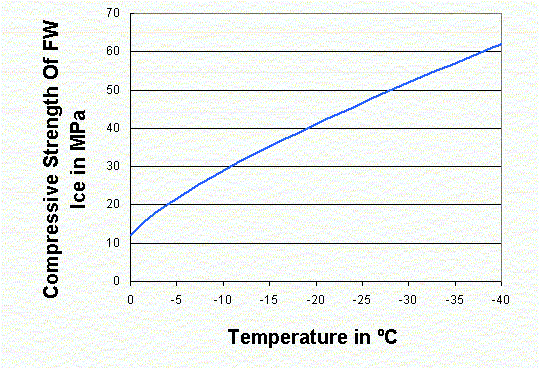Sea Ice vs. Freshwater Ice
Winter Lake Ice fom Imikpuk Lake (very transparent outside the cracks)
Sea Ice from the Chukchi Sea near Barrow (a network of brine channels is visible)
(from http://www.gi.alaska.edu/~eicken/he_publ/E03b.pdf)
Freshwater ice is formed from freshwater with air inclusion and small particles embedded in it. The strength of ice is a function of the temperature as can be seen in the following graph:
with Michel's formula (1978) for estimating ice crushing strength:
where d = 4mm
The lower the temperature, the stronger the ice.
Sea ice on the other hand is formed from saline water. This changes the ice formation as well as the ice properties. The salt inclusions are too big to be fitted into the lattice structure of the ice and therefore they get expelled and are concentrated in brine channels. The ratio of brine channel volume to the overall volume is a function of temperature: the lower the temperature the smaller the brine channel volume will be. These brine channels increase the porosity and are therefore responsible for an overall lower strength of the ice since the brine cannot take on any stress and the load has to be carried by the ice lattice alone. The following table was compiled from data by Richter-Menge (1987) and shows that sea ice has a strength that is only 4% to 43% of that of freshwater ice under a constant strain and even less for constant load conditions:
A following table was developed by the National Research Council of Canada and gives approximate loads that can be supported by lake ice and sea ice :
SAFE LOAD OPERATION FRESH ICE SEA ICE Percentage One person at rest 8 cm 13 cm 62% 0.4 ton moving slowly 10 cm 18 cm 56% 2 ton vehicle moving slowly 25 cm * 40 cm * 63% 10 ton tracked vehicle moving slowly 43 cm 66 cm 65% 13 ton aircraft parked 61 cm 102 cm 60% * estimated numbers, not provided in original table (from http://ice-glaces.ec.gc.ca/App/WsvPageDsp.cfm?ID=10167&LnId=10&Lang=eng)
From the table it can be seen that the sea ice has to be between 56% and 65% thicker than the lake ice to support the same load.




